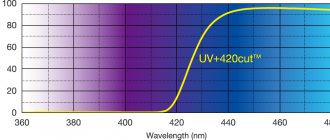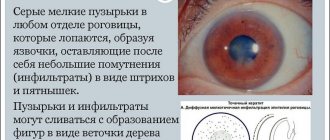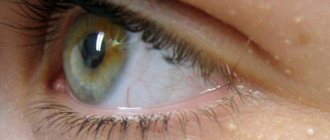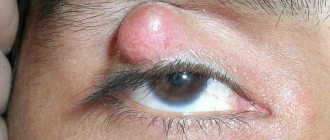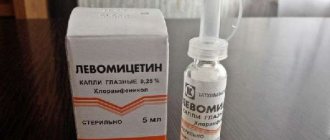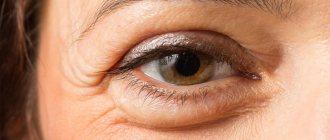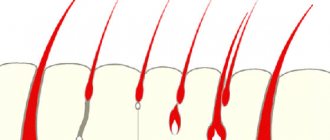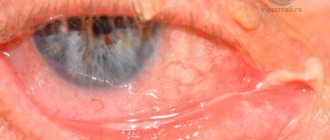Redness of the eyes is rarely isolated and is often accompanied by pain, burning, itching, lacrimation, foreign body sensation, deterioration of visual acuity, “veils, spots” before the eyes. The combination of all these diverse complaints and symptoms is combined into one syndrome, which is called “red eye syndrome”.
“Red eye syndrome” is not the name of a disease, but a pathological condition that can be a sign of illness or eye fatigue. Redness of the eyes can be caused by diseases or excessive strain on the eyes (conjunctivitis, blepharitis, dry eye syndrome, prolonged eyestrain, eye fatigue).
Drugs used to treat eye redness should be divided into drugs that alleviate the patient’s condition (painkillers, vasoconstrictors) and drugs that act on the cause (etiology) and eliminate it (antiviral, antibacterial).
What to do if such an unpleasant syndrome of visual impairment appears, like spots before the eyes.
Everything about color blindness – types, causes, diagnosis, treatment methods – can be found in this publication.
Alpha adrenergic agonists are a group of drugs that have a vasoconstrictor effect (vasoconstriction). When instilled into the eye, a-adrenergic agonists narrow the capillaries of the sclera and conjunctiva, thereby reducing redness and swelling. The following alpha-agonists are used to treat eye diseases: tetrizoline, naphazoline, oxymetazoline.
List of drugs to eliminate eye fatigue
We tried to collect popular trade names of eye drops, describing their features. But, ObaGlaza believes, it is necessary to make the final choice only after consulting a doctor and undergoing a preliminary diagnosis.
Korneregel
Kornegel
A good drug for the regeneration of tissue of the eye mucosa, accelerating the healing process of the cornea and conjunctiva. Although these are not drops, but a gel, they perfectly help relieve fatigue, irritation, and redness of the eye mucosa. It is also used for viral, fungal or bacterial infections of the cornea. Another indication for its use may be: corneal dystrophy, recurrent erosions, various physical lesions caused by wearing contact lenses. The gel is good at relieving the feeling of dry eyes when working at the computer for a long time.
The gel contains pantothenic acid (a water-soluble vitamin), which is important for the mucous membrane. This is primarily a protector that regenerates tissue and has an anti-inflammatory process. But due to its properties, Ogaglaza.ru believes, it is also prescribed to those patients who spend a lot of time working at the computer.
But the eye gel has contraindications. There may also be local allergic reactions to its individual components.
The cost in Russian pharmacies is 340-400 rubles.
Visin "Pure Tear"
Visine Pure Tear
Visine is very popular among doctors and consumers. The drug “Pure Tear” copes well with dry eyes, and is especially suitable for long-term work at the computer. Eliminates feelings of sand in the eyes, dryness and burning. Relieves swelling, constricts blood vessels.
Visine creates a thin, dense film that protects the mucous membrane from drying out and accelerates the process of its recovery. They are close in consistency to the composition of human tears. Has a patented component.
Visine Pure Tear has no contraindications based on age, and there are no restrictions on the frequency of administration. There are no side effects, notes obaglaza.
Drops are instilled into each eye after 2-3 hours. After instillation, they spread perfectly over the entire surface of the cornea. According to patient reviews, it moisturizes well and quickly eliminates itching, redness and other problems caused by adverse factors. It begins to act immediately and lasts up to 4-8 hours.
The cost of drops is 480-530 rubles.
Vial
Vial
Eye drops that are used as an anti-inflammatory agent that relieves swelling. The vial is instilled into the conjunctival sac. Well relieves itching, burning, dryness, lacrimation and pain. Often prescribed to patients who work a lot at the computer.
The main active ingredient is tetrizoline. These drops stimulate α-adrenergic receptors of the sympathetic autonomic nervous system, which promotes constriction of the blood vessels of the eye and relieves swelling. The drug is not absorbed. The vial begins to act within a few minutes after instillation. The duration of action from them lasts up to 4 hours.
The main indications for eye drops: allergic reaction to the eyes, nonspecific or catarrhal conjunctivitis, irritation of the conjunctiva of the eye from dirt, dust, chlorinated water (for example, in a swimming pool).
The vial is instilled into the conjunctival cavity of the eye, 1-2 drops in each eye up to 3 times a day. Can be used in children under 6 years of age, but only under medical supervision.
ObaGlaza draws your attention to the fact that Vial drops cannot be used for longer than 72 hours.
There are also contraindications: angle-closure glaucoma, epidermal endothelial corneal dystrophy, children under 3 years of age, intolerance to components, pregnancy and lactation.
According to ObaGlazaRu, Systane has many positive reviews about its action. Doctors consider it a good medicine for dry eyes.
They are difficult to find in pharmacies. But it is quite possible to replace it with an analogue - Visin.
Hilo chest of drawers
Hilo chest of drawers
Moisturizing eye drops based on hyaluronic acid. Prescribed for increased dryness and physical damage to the cornea of the eye, discomfort from contact lenses. They are also well suited for working while sitting at a computer.
Types of eye drops for fatigue
To overcome such side effects associated with working at a computer, various medications are offered in medicine. The drops are very convenient to use to protect the organs of vision from irritation and fatigue.
They can be classified into three subgroups, each of which is responsible for eliminating certain symptoms:
- preparations for the restoration of the mucous membrane of the eye;
- drops that eliminate dryness of the visual organ;
- agents that constrict the blood vessels of the eyes and relieve puffiness.
General recommendations for red eyes
Do not self-medicate if:
- Congestion of the sclera and conjunctiva is associated with an inflammatory process of bacterial and viral etiology;
- The redness is persistent and there is no effect from alpha-agonists;
- Redness is accompanied by pain, blurred vision, and discharge from the eye;
Find out current methods of treating iridocyclitis, as well as methods of diagnosis and prevention of the disease.
What epicanthus is and methods of its treatment can be found in this publication.
Apply eye drops correctly
- Wash your hands before administering the drug;
- Pull back your lower eyelid, look up without raising your head;
- Without touching the pipette to the mucous membrane, inject the required number of drops into the inner corner (closer to the bridge of the nose) of the eye;
- Blink frequently several times and try to prevent the medication from leaking out of your eye.
Drugs such as antibiotics, glucocorticosteroids, non-steroidal anti-inflammatory drugs are used only as prescribed by a doctor; their uncontrolled use can cause more harm than cure.
Redness of the eyes can be caused by a serious disease (dry eye syndrome, glaucoma, tumor process), which can only be diagnosed by a specialist.
If the redness of the eye is associated with a disease, such as glaucoma, “dry eye syndrome,” then the main treatment is aimed at treating this disease: antiglaucoma drugs, etc. are prescribed.
Dosage, method, frequency of use of alpha-adrenergic agonists
The drugs are instilled into the conjunctival sac, 1 drop 3 times a day. The duration of use should not exceed 7-10 days. If two-day use does not produce an effect, then you should stop taking the drug and consult your doctor.
Possible side effects: headache, increased blood pressure (blood pressure), palpitations. It should not be taken if you have glaucoma (angle-closure form), pregnancy and lactation, severe diseases of the cardiovascular system, pheochromocytoma.
In pediatric practice, a-adrenergic agonists are not used until the age of one; from 2 years of age, naphazoline can be prescribed.
A well-known drug in this group (due to active advertising) is Visine. The active ingredient in Visine is tetrizoline. Visin is used for blood filling of the conjunctiva caused by exposure to physical and chemical factors (dust, smoke, contact lenses, eye fatigue);
Drugs with a combined effect, in which an α-adrenergic agonist is combined with an antihistamine. Antihistamines are used for allergic reactions.
Combined drops to relieve redness of the eyes should be used for redness of the eyes of an allergenic nature (allergic conjunctivitis, blepharitis). Combined eye medications include: Spersallerg (active ingredients tetrazoline and antazoline), Allergophthal (naphazoline and tetrazoline);
If redness of the eyes is caused by conjunctivitis of bacterial or viral origin, then antibacterial and antiviral drugs are prescribed for treatment, respectively.
The following antibiotics are used in eye redness drops: chloramphenicol, tetracycline, aminoglycosides and macrolides. The drugs can be used topically (eye drops, ointment) or systemically (tablets, injections). Antiviral drugs for the treatment of conjunctivitis (eye drops): tebrofen, oftan, interferon.
To combat redness (hyperemia) of the eyes, antiseptic substances are used, which also have an antibacterial, cauterizing effect, and reduce pain sensitivity. The following drugs are prescribed (locally): silver nitrate solution (lapis), zinc sulfate solution, furatsilin solution;
Nonsteroidal anti-inflammatory drugs are used in the treatment of non-infectious conjunctivitis and post-traumatic inflammation. Diclofenac solution (eye drops) is prescribed 1 drop 3 times a day, the course of treatment is on average 7 days;
Glucocorticosteroids (GCS) are prescribed locally for allergic redness of the eyes. In combination with an antibiotic (gentamicin) it is used in the treatment of staphylococcal infections (keratoconjunctivitis, blepharoconjunctivitis).
In the treatment of eye diseases, the following glucocorticosteroids (eye drops) are used: solutions of betamethasone, prednisolone, Garazon (combined drug);
Auxiliary drugs that help cope with the inflammatory process - vitamins and immunostimulating drugs, are prescribed in eye drops or systemically (injections).
Prevention measures
To prevent redness of the eyes from the computer in the future, you need to properly organize your work at the PC.
Here are some tips to help you maintain normal vision:
- Alternate between computer work and rest. Try to give your eyes a little break every 15-20 minutes. At this time, you can simply close your eyelids, “palm”, and blink.
- In between doing work, you can do simple gymnastics: move your eyes to the sides, up/down, and make circular movements. These exercises can be done while sitting at the computer.
- Look into the distance periodically. You can draw a circle on the window glass and look first at it, then as if through it, at a distant distance.
- Take enough vitamins. They are found in juices, fresh vegetables and fruits. Vitamin A is necessary for the proper functioning of the retina. Vitamin C strengthens blood vessels, vitamin E helps preserve vision.
- Take more walks in the fresh air. Oxygen is necessary for proper nutrition of eye tissues.
- Adjust the monitor so that it is comfortable for your eyes. Select the optimal brightness and color palette.
- Position the monitor away from your face. The distance to the eyes should be 40-50 cm. Select the correct angle of the screen. It is recommended to position the monitor so that its top edge is level with your eyes. Turn the monitor so that the bottom edge is closer to the face and push it forward.
- Position your computer so that natural light comes from the left. There should be no glare on the monitor. Natural and artificial lighting should be optimal.
- If your job involves a computer, limit eye strain in your free time: watch less TV and read.
By following preventive measures and proper organization of work, you can preserve vision and prevent redness and eye strain. It is worth visiting an ophthalmologist periodically for a routine examination. If you follow these recommendations, your eyes will stay healthy longer.
Author: Alla Lomova, ophthalmologist, especially for Okulist.pro

